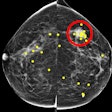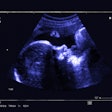More social support and living with a spouse or partner are tied to more breast cancer screening, according to research published October 17 by the American Cancer Society (ACS).
A team led by Jordan Baeker Bispo, PhD, from the ACS found that overall, screening participation was supported by higher perceived social support among all cancer screening types included in the survey study, with the association being strongest for breast cancer screening.
“The findings really underscore the importance of addressing some of the unmet social needs of strained parents and caregivers who may be struggling to access preventive services,” Bispo told AuntMinnie.com.
Previous studies have shown significant associations between social support and the increased use of preventive care services, such as cancer screening. The researchers also suggested that living arrangements and residential stability may be important structural sources of social support. However, they noted that few studies have examined their impact on cancer screening.
Bispo and colleagues analyzed how perceived social support, living arrangements, and residential stability may be tied to routine screening for breast, cervical, and colorectal cancers in the U.S. They also studied whether these associations varied by age for cervical cancer screening, considering the wide age range for screening recommendations.
Final analysis included data collected from the 2021 National Health Interview Survey. This included 6,041 women eligible for breast cancer screening, 8,517 women eligible for cervical cancer screening, and 5,302 patients eligible for colorectal cancer screening.
The team found that the adjusted odds of screening were 39% lower for breast cancer (odds ratio [OR] = 0.61) and 24% lower for cervical cancer (OR = 0.76) among women who reported never or rarely having social support versus those who reported having higher social support.
Also, patients with a spouse or partner reported having higher odds of attending breast and female colorectal cancer screening, with ORs of 1.44 and 1.42, respectively. However, the researchers did not observe any significant benefit of living with a spouse or partner for women who also lived with children.
For cervical cancer screening, the team found that women ages 21 to 34 years who had less residential stability and living with children had increased cervical cancer screening. Upward social mobility and access to prenatal care could boost screening in these women, the study authors wrote.
Bispo said that these trends could be driven by unique factors for each screening type. For the benefit of living with a spouse or partner, she said that emotional support and lower health insurance costs from shared accounts may be drivers. When it comes to living with children, Bispo added that the lack of benefit may be due to cost and time restrictions. For cervical cancer, the trends observed in the study may reflect healthcare access to gynecological care.
“At the policy level, things like addressing access to affordable childcare and paid sick leave could be approaches that have a downstream benefit on preventive care utilization for adults who are experiencing social strain,” Bispo told AuntMinnie.com. “Also, connecting patients to community health workers and patient navigators could be helpful in overcoming some of those social and economic barriers.”
She said that the team may next explore whether the associations observed in the current study vary by different socioeconomic factors, as well as race and ethnicity.
The full study can be found here.



















